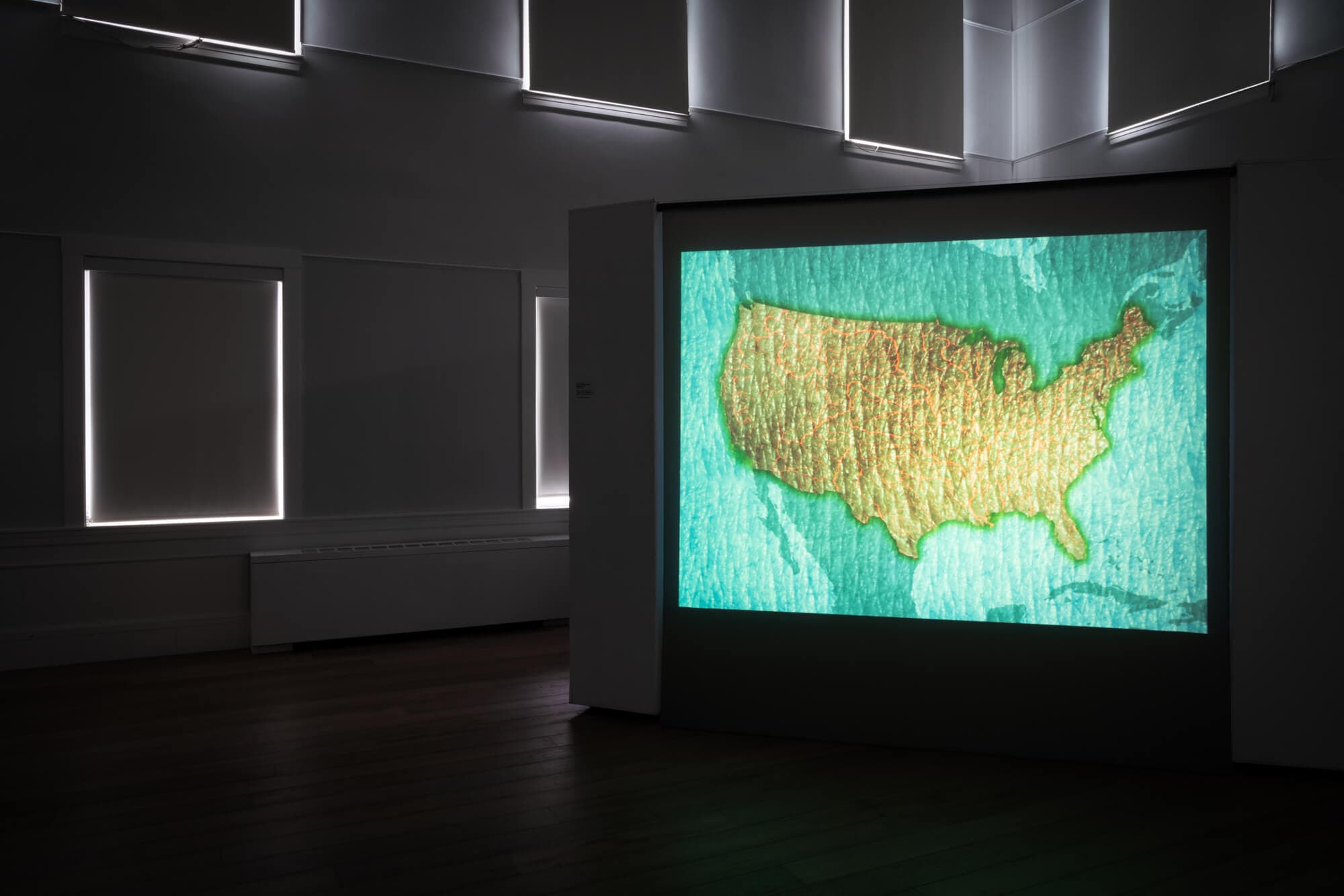Recently I’ve had multiple encounters with Hokusai’s Under the Wave Off Kanagawa, aka The Great Wave. The image appeared in my inbox, as the MFA has a Hokusai exhibition coming up, and on a late night spent reading Gabrielle Zevin’s novel Tomorrow and Tomorrow and Tomorrow, which puts the iconic 1831 woodcut on the cover and in the plot—a poster of it helps inspire the first video game the main characters create together. Looking closely, I was reminded why this beautiful and terrible scene is one of the world’s most reproduced images: the graphic punch of Prussian blue, the seafoam carved into sharp claws, the scale of the wave dwarfing both a distant Mount Fuji and the three boats below whose passengers are about to perish.
I was also looking at The Great Wave with fresh eyes because I’d just visited “Waterlines: Stories of Urban Ebb and Flow,” an exhibition on view at the Somerville Museum through March 22 and scheduled to travel to Chestnut Hill’s Waterworks Museum in a different form. Curated by Arlinda Shtuni, it gathers five works by five local artists and artist teams exploring ecological, social, and spiritual dimensions of a substance that covers 70 percent of the planet and composes 60 percent of our bodies yet can sometimes seem at a remove to urban dwellers, even when it’s rushing beneath our feet. It’s a timeless source of inspiration but a timely one too in an era in which we are increasingly aware of how the waters that sustain us also threaten us and are threatened by us.
The show opens in a darkened gallery with a sight that seems pulled from a dream: water flowing down (or is it up?) the museum’s centerpiece, a 1792 flying double staircase designed by Charles Bulfinch for a merchant’s nearby mansion that later housed the McLean Asylum for the Insane. No architectural treasures have been harmed during the course of the exhibition—Georgie Friedman’s video installation Confluere (Latin for “to flow together”) delivers the impossible image of a natural force overrunning an exquisite, emphatically manmade form without inflicting any damage, each step shimmering with refracted light. This installation, like the other two video works in this room, is silent, but Dialogues with Water, a series of soundscapes created by Northeastern music students guided by Professor Hubert Ho, supplies ambient splashes and crashes.
Confluere is site-specific, and a strong sense of place anchors most of the other works on view, too. That’s immediately clear in the case of You Are Here by A+J Art+Design, the moniker of artists Ann Hirsch and Jeremy Angier. Created with digital and analog animation techniques, their six-minute video projects fourteen waterscapes across the topography of Somerville. Watching waves roll across the city is unsettling in a time of climate crisis, but the work also offers plenty of wit and whimsy: At one point, the blue circle representing the location of the Somerville Museum becomes a bathtub drain as everything in the surrounding map—the Mystic and Charles Rivers, the familiar squares of Camberville—starts to swirl.
A map also features in duo Caitlin & Misha’s Surface Tension, which traces the rivers of the continental US in red rather than the usual blue, making them look like fissures or fault lines or capillaries carrying the country’s lifeblood. Raindrops seem to sprinkle across the screen; soon the dimples on the surface deepen into dramatic undulations. The exhibition program reveals that the visualization draws on daily streamflow data from 11,000 sites, starting with locations experiencing minimal changes and ending with those experiencing the most anomalous streamflow. This pulsating picture might have moved me more with additional context, but it did get me Googling “anomalous streamflow”—yet another effect of climate change and a potential indicator of melting snowpack, flooding, or drought.
A second gallery pairs works that use tangible materials to investigate mystical aspects of water. Heather Kapplow’s Seeking the Source explores dowsing—a centuries-old folk practice for finding water sources that’s persisted despite debunking—and the place of intuition in a science- and tech-mediated world. Its five vitrines enclose seventeen divining rods and pendulums that include natural finds (the smallest an inch-long twig, the largest a forked branch as thick as my forearm) as well as Amazon buys and one crafty collaborative piece festooned with feathers, ribbon, yarn, and googly eyes. Accompanying QR codes lead to soundtracks for each object, and appealingly chatty text explains where and how they were acquired. Most sources—a peach tree in the artist’s Allston front yard, the street she grew up on in JP—hold personal significance, and the project adds up to a kind of self-portrait or map tracing Kapplow’s travels.
Faith Johnson’s The Magic of Water reflects her wanderings, too—almost literally. She’s carefully arranged an octagonal mirror, a cut-glass bowl, a geometric vase, and other glass and acrylic found objects to form a sparkling vessel fit for something precious, filling it with waters she’s gathered from the Mystic River, Walden Pond, and a secret spring in the Emerald Necklace. Johnson has spent quality time with each of these sources—swimming frequently in Walden Pond—and her silvery wall text invites us to imagine our bodies and our bodies of water returning to balance. The artist will lead a guided meditation on March 22, World Water Day, as part of the exhibition’s closing celebration. It’s a last chance to check out a show that’s less a great wave than a plunge pool: small but bracing.
“Waterlines: Stories of Urban Ebb and Flow” is on view at the Somerville Museum through March 22.





